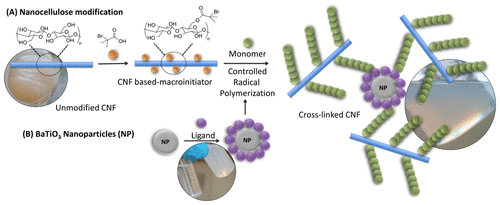当前位置:
X-MOL 学术
›
Biomacromolecules
›
论文详情
Our official English website, www.x-mol.net, welcomes your
feedback! (Note: you will need to create a separate account there.)
Surface-Initiated Controlled Radical Polymerization Approach to In Situ Cross-Link Cellulose Nanofibrils with Inorganic Nanoparticles.
Biomacromolecules ( IF 5.5 ) Pub Date : 2020-04-06 , DOI: 10.1021/acs.biomac.0c00210 Julien R G Navarro 1 , Jowan Rostami 2 , Astrid Ahlinder 2 , J Benedikt Mietner 1 , Diana Bernin 3 , Bodo Saake 1 , Ulrica Edlund 2
Biomacromolecules ( IF 5.5 ) Pub Date : 2020-04-06 , DOI: 10.1021/acs.biomac.0c00210 Julien R G Navarro 1 , Jowan Rostami 2 , Astrid Ahlinder 2 , J Benedikt Mietner 1 , Diana Bernin 3 , Bodo Saake 1 , Ulrica Edlund 2
Affiliation

|
This paper investigates a strategy to convert hydrophilic cellulose nanofibrils (CNF) into a hydrophobic highly cross-linked network made of cellulose nanofibrils and inorganic nanoparticles. First, the cellulose nanofibrils were chemically modified through an esterification reaction to produce a nanocellulose-based macroinitiator. Barium titanate (BaTiO3, BTO) nanoparticles were surface-modified by introducing a specific monomer on their outer-shell surface. Finally, we studied the ability of the nanocellulose-based macroinitiator to initiate a single electron transfer living radical polymerization of stearyl acrylate (SA) in the presence of the surface-modified nanoparticles. The BTO nanoparticles will transfer new properties to the nanocellulose network and act as a cross-linking agent between the nanocellulose fibrils, while the monomer (SA) directly influences the hydrophilic-lipophilic balance. The pristine CNF and the nanoparticle cross-linked CNF are characterized by FTIR, SEM, and solid-state 13C NMR. Rheological and dynamic mechanical analyses revealed a high dregee of cross-linking.
中文翻译:

表面引发的受控自由基聚合方法,用于无机无机粒子的原位交联纤维素纳米原纤维。
本文研究了一种将亲水性纤维素纳米原纤维(CNF)转化为由纤维素纳米原纤维和无机纳米粒子构成的疏水性高度交联网络的策略。首先,通过酯化反应对纤维素纳米原纤维进行化学改性,以产生基于纳米纤维素的大分子引发剂。钛酸钡(BaTiO3,BTO)纳米颗粒通过在其外壳表面引入特定单体进行表面改性。最后,我们研究了基于纳米纤维素的大分子引发剂在表面改性纳米粒子存在下引发丙烯酸硬脂基丙烯酸酯(SA)的单电子转移活性自由基聚合的能力。BTO纳米粒子将向纳米纤维素网络传递新特性,并充当纳米纤维素原纤维之间的交联剂,而单体(SA)直接影响亲水-亲脂平衡。原始的CNF和纳米粒子交联的CNF用FTIR,SEM和固态13C NMR表征。流变学和动态力学分析表明交联度很高。
更新日期:2020-03-30
中文翻译:

表面引发的受控自由基聚合方法,用于无机无机粒子的原位交联纤维素纳米原纤维。
本文研究了一种将亲水性纤维素纳米原纤维(CNF)转化为由纤维素纳米原纤维和无机纳米粒子构成的疏水性高度交联网络的策略。首先,通过酯化反应对纤维素纳米原纤维进行化学改性,以产生基于纳米纤维素的大分子引发剂。钛酸钡(BaTiO3,BTO)纳米颗粒通过在其外壳表面引入特定单体进行表面改性。最后,我们研究了基于纳米纤维素的大分子引发剂在表面改性纳米粒子存在下引发丙烯酸硬脂基丙烯酸酯(SA)的单电子转移活性自由基聚合的能力。BTO纳米粒子将向纳米纤维素网络传递新特性,并充当纳米纤维素原纤维之间的交联剂,而单体(SA)直接影响亲水-亲脂平衡。原始的CNF和纳米粒子交联的CNF用FTIR,SEM和固态13C NMR表征。流变学和动态力学分析表明交联度很高。











































 京公网安备 11010802027423号
京公网安备 11010802027423号